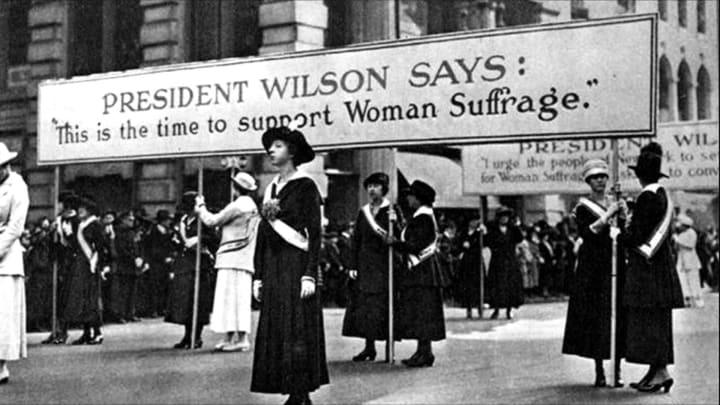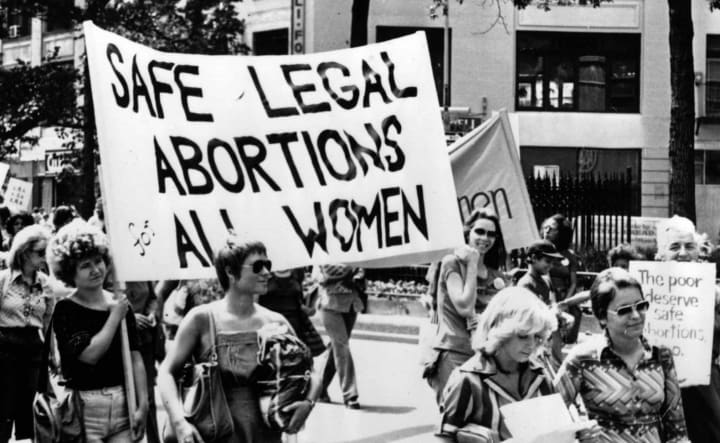A Timeline of the Feminist Movement
Feminism has been around for a while. This timeline of the feminist movement shows how it has evolved in America over the years.

Feminism has changed the world we live in, and these days, many of us couldn't imagine living in a world like The Handmaid's Tale. Not too long ago, though, that was basically what reality was like for the ladyfolk throughout the world.
Part of being a good feminist is learning where we came from — and how much we've already achieved. This timeline of the feminist movement in America will show how far we've come, how far we have yet to go, and why it evolved the way it did.
First Wave Feminism (18th century to 1920)

To start off our timeline of the feminist movement, we're going to talk about First Wave Feminism.
Throughout the late 18th, 19th, and early 20th century, First Wave Feminism was what roiled the American political scene. This was a form of feminism that championed certain specific causes dealing with a woman's right to have a voice in society. These causes included:
- Women's Suffrage. The right to vote was granted thanks to Susan B. Anthony and the feminists who followed in her footstep.
- The Right To Divorce. Divorce wasn't always legal in the United States. First Wave Feminists actually fought for the right to leave their husbands.
- Racism. The First Wave of feminists also included a lot of abolitionists and black rights champions as well. One key example was Soujourner Truth.
Some of the best feminist books ever written came from First Wave Feminism. So, if you love feminist lit, you probably would have enjoyed First Wave Feminism.
Second Wave Feminism (1920 to 1970)

Second Wave Feminism was a movement that began to take note of injustices dealing with wage equality, sexualization, civil rights, and also the way women were treated in the workplace. This is the point on every timeline of the feminist movement that people easily recognize.
By the 1920s Flapper Movement, women were tired of being told to be demure and ladylike while men did whatever they wanted. By the 1960s, famous feminists like Gloria Steinem pointed out how many double-standards existed in society — and avidly fought against them.
Some of the things that Second Wave Feminism started included:
- Body Positivity. Fat feminism first appeared in the 1960s, despite it being considered a more Third Wave form of feminism.
- Civil Rights. Many feminists actually took a very strong stance for civil rights as well. Anti-war, anti-racism rhetoric was a very large portion of Second Wave Feminism.
- Abortion Rights. This was the era in which Roe vs. Wade was passed. Second Wave Feminism also helped legalize contraception and destigmatize it. If you used condoms or the Pill, this is the feminist wave you have to thank.
- Sexual Freedom. The 60s also saw a call for an end to stigmatizing sex. This is still an ongoing aspect of feminism.
If you use birth control, hold a job in a male-dominated field, are against rape, or are pro-choice, you have Second Wave Feminists to thank for that. This second wave of feminism was often marginalized, because it wasn't composed of mostly white, middle-to-upper class women.
Third Wave Feminism (1980 to 2000)

Third Wave Feminism started with empowered ladies who wanted to have it all. This was a form of feminism that stopped trying to "normalize" gender constructs, sexuality, and identity politics. This was a time of radical riot girls, punk rock as a form of feminism, and a time when people began to embrace LGBTQ causes.
Some of the issues that Third Wave Feminism tackled or helped tackle included:
- LGBTQ Rights. This was the time when people began to normalize non-cis, non-het relationships. If you have a loved one who was granted the right to marry, or if you have a friend who now has equal opportunity at the workplace, this is the wave of feminism to thank.
- Environmentalism. Eco-feminism is a thing, and this was about the time when women realized it's up to us to save the Earth from turning into Love Canal.
- Body Positivity. This was also a time when women started getting in touch with their natural selves and embracing a lot of their natural body issues. Body positivity and calling out the entertainment industry for double standards became the norm.
- Fat Positivity. Calling out thin privilegeen masse is also a common marker of Third Wave Feminism.
- Sex Positivity. On every timeline of the feminist movement, Third Wave Feminism is credited with being the first group to openly call out the double standards of men being "studs" and women being "sluts."
- Brain + Beauty. Along with critiquing society's stigma towards women who didn't fit beauty norms, many Third Wave Feminists also emphasized that ladies can have both brains and beauty.
At this point on the timeline of the feminist movement, feminism became more than a thought. It became a lifestyle. There were feminist bands like Three Non-Blondes, pro-LGBTQ sites, women-only forums, and even entire subcultures dealing with feminism.
Fourth Wave Feminism (2000 to today)

This is the end of our timeline of the feminist movement — but it's just the beginning of the Fourth Wave.
Fourth Wave Feminism is still in its fledgling state, however, it's really easy to point out certain characteristics of it. This movement is overwhelmingly accepting of LGBTQ issues and eschews the idea of keeping things to two genders when discussing equal rights.
It's a body-positive movement that is also about sex-positivity. Transpeople are welcome, but misandrists are not. More importantly, Fourth Wave Feminism seems to be mostly an online discourse.
As of right now, there seems to be a divide on a number of issues in the Fourth Wave Feminist movement, most commonly, abortion. Many Fourth Wave Feminists also eschew the label of "feminist" for one reason or another.
It's hard to tell what we will get from Fourth Wave Feminism. However, it's safe to say we will learn more about egalitarianism and inclusiveness for all.
About the Creator
Jules Fortman
Modern feminist making moves one pink hat at a time.






Comments
There are no comments for this story
Be the first to respond and start the conversation.